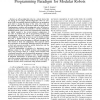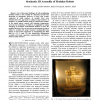18 search results - page 3 / 4 » HyperNEAT for Locomotion Control in Modular Robots |
AROBOTS
1999
13 years 5 months ago
1999
This paper outlines aspects of locomotor control in insects that may serve as the basis for the design of controllers for autonomous hexapod robots. Control of insect walking can b...
TROB
2002
2002
Hormone-inspired adaptive communication and distributed control for CONRO self-reconfigurable robots
13 years 5 months ago
This paper presents a biologically inspired approach to two basic problems in modular self-reconfigurable robots: adaptive communication in self-reconfigurable and dynamic networks...
ROBOCOMM
2007
IEEE
13 years 11 months ago
2007
IEEE
—A self-reconfigurable robot is a robotic device that can change its own shape. Self-reconfigurable robots are commonly built from multiple identical modules that can manipulat...
IROS
2009
IEEE
13 years 12 months ago
2009
IEEE
— In nature, animal groups achieve robustness and scalability with each individual executes a simple and adaptive strategy. Inspired by this phenomenon, we propose a decentralize...
ICRA
2010
IEEE
13 years 3 months ago
2010
IEEE
—One of the grand challenges of self-reconfiguring modular robotics is the assembly of a functional system from thousands of components. However, to date, only systems comprised ...


